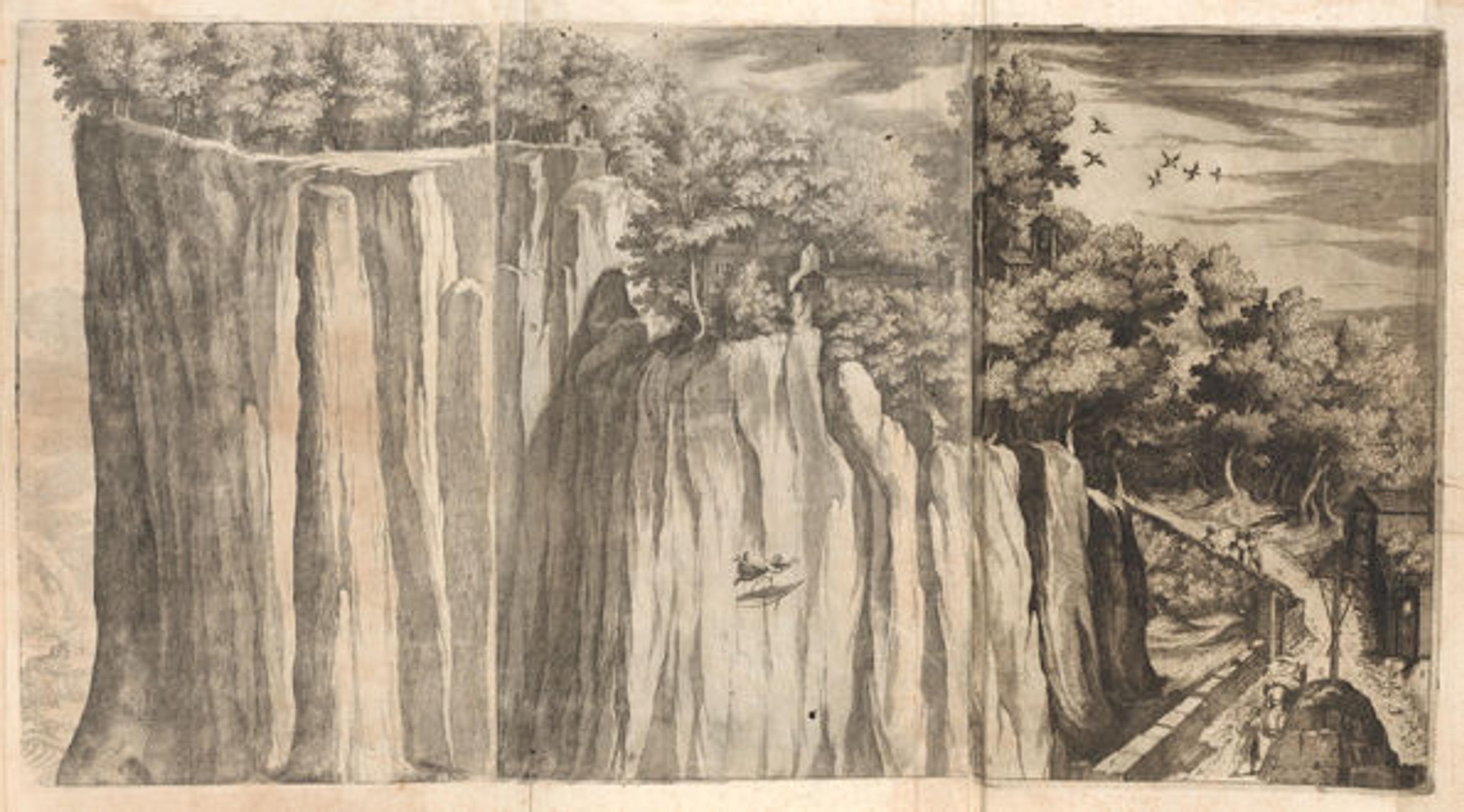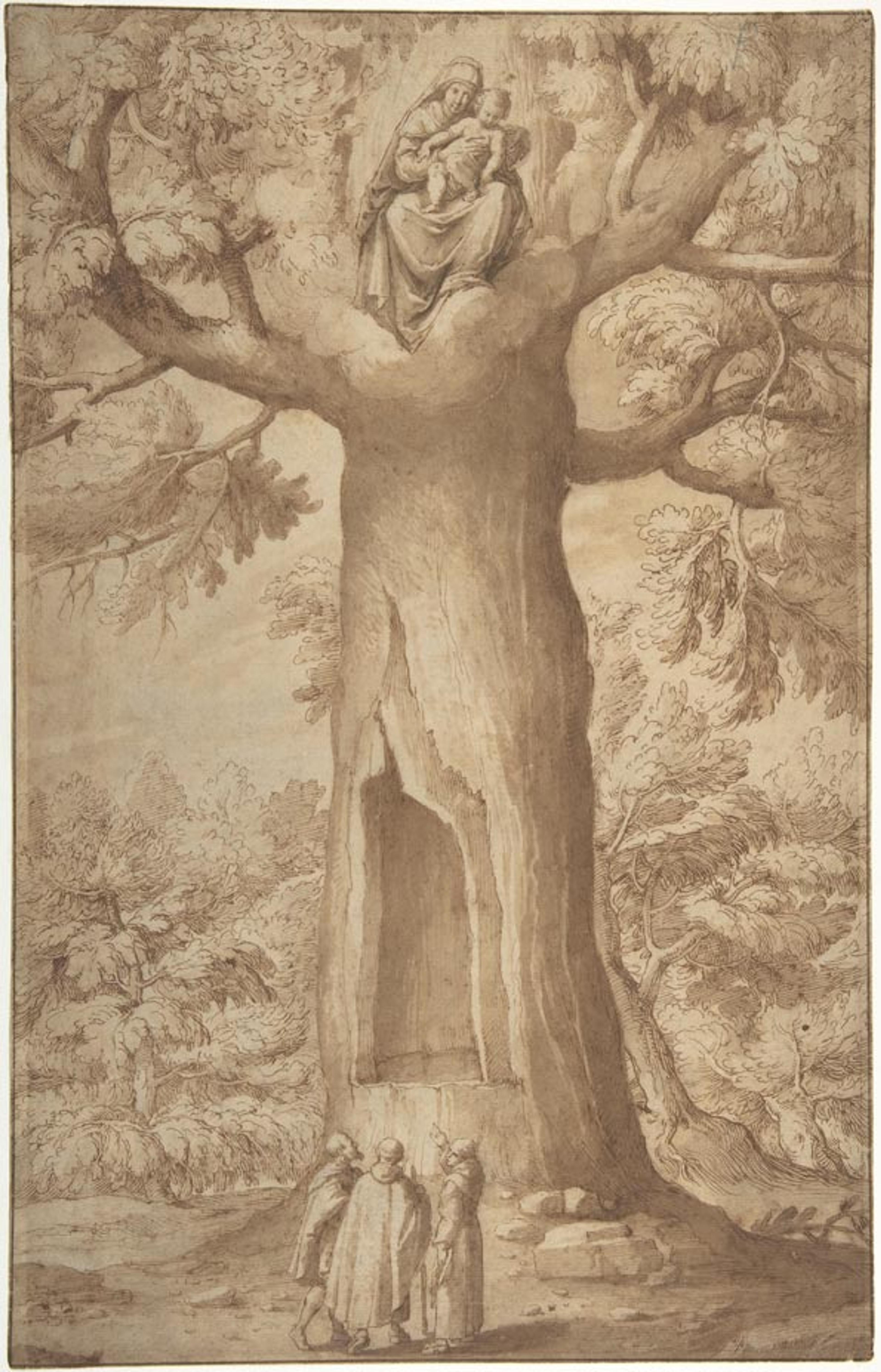In the Footsteps of Saint Francis

Rafaello Schiaminossi (Italian, 1572–1622). Monte della Vernia from the Road of Casentino, Plate A (detail), 1612. Etching; 18 5/16 x 32 11/16 in. (46.5 x 83 cm). The Metropolitan Museum of Art, New York, The Elisha Whittelsey Collection, The Elisha Whittelsey Fund, 1949 (49.62.11)
«Published in Florence by Fra Lino Moroni in 1612, the Descrizione del Sacro Monte della Vernia (Description of the Sacred Mount Alverno) serves as a guide to Monte della Vernia (today known as La Verna) in the Tuscan Apennines. Monte della Vernia was the location where Saint Francis of Assisi retreated in 1224 for a forty-day period of fasting and meditation. It was there where he had the vision of an angel carrying the crucified Christ and experienced the stigmata.»
Bound in vellum with "Monte di Vernia" inked on the spine, the book contains twenty-six prints with letterpress descriptions accompanying the individual prints made after designs by Jacopo Ligozzi (1547–1627). The guidebook resulted from a visit Ligozzi made to the Monte della Vernia in 1607 while accompanied by Fra Lino Moroni, a Franciscan Observant and the provincial minister for the Tuscan order at the time. The purpose of the guidebook, which was illustrated and described in tremendous detail, was to increase the attention given to this holy site by pilgrims, as well as to provide a vivid account to those unable to travel to the location themselves.

Rafaello Schiaminossi (Italian, 1572–1622). Monte della Vernia from the Road of Casentino, Plate A, 1612. Etching; 18 5/16 x 32 11/16 in. (46.5 x 83 cm). The Metropolitan Museum of Art, New York, The Elisha Whittelsey Collection, The Elisha Whittelsey Fund, 1949 (49.62.11)
Ligozzi's detailed drawings were translated into etchings by Raffaello Schiaminossi (1572–1622) and engravings by Domenico Falcini (1575–1631). Two of the prints in the text are large fold-out illustrations consisting of two or three sheets, while others in the book contain superimposed details, such as rocks, which are adhered to the print and can be folded back to reveal other details on the sheet beneath.

Rafaello Schiaminossi (Italian, 1572–1622). Monte della Vernia from the Road of Casentino, Plate A, 1612. Etching; 18 5/16 x 32 11/16 in. (46.5 x 83 cm). The Metropolitan Museum of Art, New York, The Elisha Whittelsey Collection, The Elisha Whittelsey Fund, 1949 (49.62.11)
Three sheets comprise the fold-out illustration of Plate A, which, when combined, show La Verna as seen from the perspective of a viewer approaching from Florence and the Casentino. The print was etched by Schiaminossi and signed with his monogram at the lower right of the second sheet. In addition to the descriptive text on the opposite page, the print—as with all others in the book—is lettered to correspond to a legend. The image serves to illustrate important events that took place at this holy site.
For example, a friar lettered "V" is depicted as having fallen off of the ledge. According to legend, he fell more than 130 feet; however, he invoked the name of Saint Francis on his descent and therefore remained unharmed. At the location labelled "H," the Devil attempted to throw Saint Francis over the precipice.

Jacopo Ligozzi (Italian, 1547–1627). Beech of the Madonna at La Verna, 1605–07. Pen and brown ink, brush and brown wash and with traces of gray, over black chalk; 15 13/16 x 10 1/18 in. (40.2 x 25.7 cm). The Metropolitan Museum of Art, New York, Harry G. Sperling Fund, 1983 (1983.131.1)
In addition to the bound volume of plates, the Museum also owns one of the preparatory drawings by Ligozzi. This preparatory drawing is one of several that have been identified as relating to Fra Lino Moroni's text and is the same size as the corresponding print, but shown in reverse and with incised outlines. The drawing, for the plate marked "P," is the Beech of the Madonna at La Verna. In this work the Madonna and Christ Child are seated amidst clouds in the branches of the beech tree. The Madonna and Child gaze below at three monks in the wooded landscape, one of whom gestures upwards towards them.
Alexa Schwartz
Alexa Schwartz is a collections management assistant in the Department of Drawings and Prints.